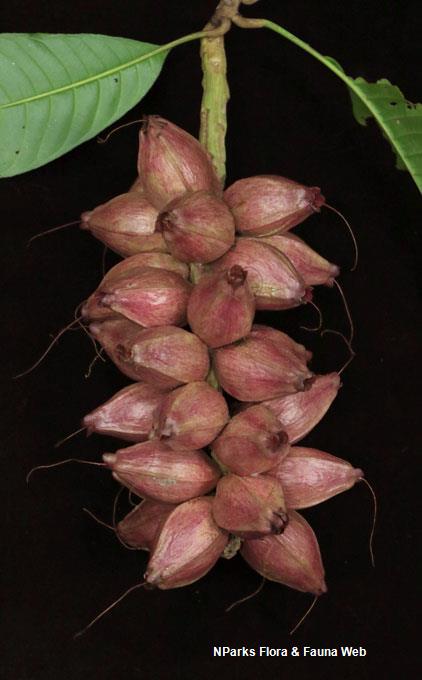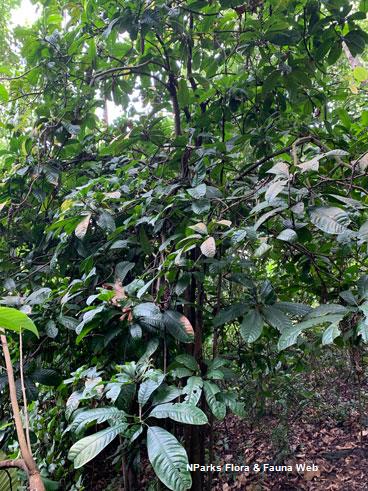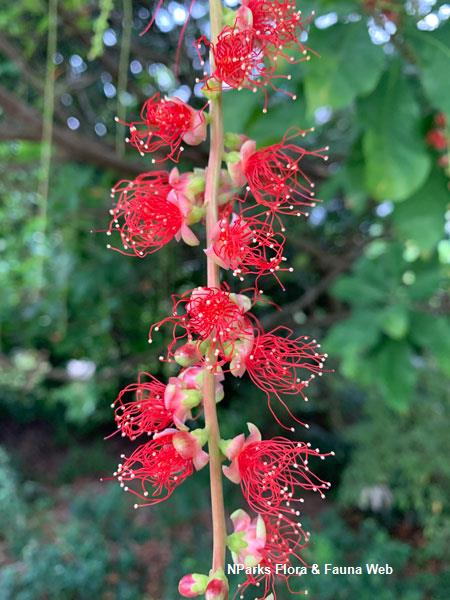
Back
Barringtonia macrostachya (Jack) Kurz
| Family Name: | Lecythidaceae |
| Synonyms: | Barringtonia cylindristachya Griff., Barringtonia pendula auct. non (Griff.) Kurz <3> |
| Common Name: | Red Putat, Putat Gajah, Buah Putat |
Barringtonia macrostachya or Red Putat is a shrub to tree native to Singapore. Growing to 30 m tall, it has leathery leaves with looping veins and a long to tail-like tip. Flowers are 4 petalled, pinkish-red crimson or striped red with numerous pink to deep red stamens held on an long pendulous inflorescence found along the tips or branchlets. The fruit is a tear-shaped, 4-angled berry that ripens from green to dull red when matured.
Name
Classifications and Characteristics
| Plant Division | Angiosperms (Flowering Seed Plants) (Dicotyledon) |
|---|---|
| Plant Growth Form | Tree (Medium (16m-30m), Shrubby (1m-5m), Small (6m-15m)), Shrub |
| Maximum Height | 30 m |
Biogeography
| Native Distribution | China, Myanmar, Thailand, Vietnam, Sumatra, Peninsular Malaysia, Borneo, Philippines, Sulawesi, Moluccas, Singapore |
|---|---|
| Native Habitat | Terrestrial (Primary Rainforest, Secondary Rainforest, Freshwater Swamp Forest) |
| Preferred Climate Zone | Tropical |
| Local Conservation Status | Native to Singapore (Critically Endangered (CR)) |
Description and Ethnobotany
| Growth Form | It is a large shrub to tree that can reach between 4 - 30 m tall. |
|---|---|
| Foliage | Leaves are leathery, obovate-oblong to oblong, measuring 10 - 45 cm long by 4 - 10 cm wide. It has 14 - 21 pairs of looping veins, margins are shallowly toothed with a long to tail-like tip. The leaves are held on a petiole, 2.5 - 17 cm long, slightly winged near the base of the leaf. |
| Flowers | Flowers are held on a long pendulous inflorescence of up to 60 flowers directly attached to the main flower stalk. The inflorescence is found along the tip or branchlets measuring 10 - 75 cm long. Flowers are 4 petalled, pinkish-red crimson or striped red with numerous pink to deep red stamens. |
| Fruit | The fruit is tear-shaped, 4-angled berry measuring 5.5 - 9 cm long, 2 - 4 cm wide ripening from green to dull red coloured. The seed is also tear-shaped, 3 - 4.5 cm long. |
| Habitat | Occurs in primary and secondary forests, in disturbed forests, along rivers and hills on inundated forests and swampy areas to 750 m in altitude. <1 & 2> |
| Cultivation | It can be propagated by seed. |
| Etymology | The genus Barringtonia is named after an English naturalist, The Hon. Daines Barrington (1727–1800). The species epithet macrostachya, Greek, makros meaning long, stachos meaning spiked in reference to the inflorescence. |
Landscaping Features
| Desirable Plant Features | Ornamental Flowers |
|---|
Fauna, Pollination and Dispersal
| Fauna Pollination Dispersal Associated Fauna | Bat Food, Moth Food Plant |
|---|
Plant Care and Propagation
| Light Preference | Semi-Shade |
|---|---|
| Water Preference | Moderate Water |
| Plant Growth Rate | Moderate |
| Rootzone Tolerance | Fertile Loamy Soils, Moist Soils, Well-Drained Soils |
| Propagation Method | Seed |
Foliar
| Foliage Retention | Evergreen |
|---|---|
| Mature Foliage Colour(s) | Green |
| Mature Foliage Texture(s) | Leathery |
| Foliar Type | Simple / Unifoliate |
| Foliar Arrangement Along Stem | Spiral |
| Foliar Attachment to Stem | Petiolate |
| Foliar Shape(s) | |
| Foliar Venation | Reticulate |
| Foliar Margin | Serrate / Toothed, Crenulate |
| Foliar Apex - Tip | Cuspidate, Caudate |
| Foliar Base | Cuneate |
Non - Foliar and Storage
| Stem Type & Modification | Woody |
|---|
Floral (Angiosperm)
| Flower & Plant Sexuality | Bisexual Flowers , Bisexual Flowers |
| Flower Colour(s) | Pink, Red |
|---|
| Flower Grouping | Cluster / Inflorescence |
| Flower Location | Terminal |
| Flower Symmetry | Radial |
| Flowering Opening Time | Night (dusk to dawn) |
| Flowering Habit | Polycarpic |
Fruit, Seed and Spore
| Mature Fruit Colour(s) | Red |
|---|---|
| Fruit Classification | Simple Fruit |
| Fruit Type | Fleshy Fruit , Berry |
| Seed Quantity Per Fruit | Few (1-5) |
References
| References | <1> Prance, G.T. (2012) Barringtonia. In: Kiew, R., Chung, R.C.K., Saw, L.G. & Soepadmo, E. (ed.) Lecythidaceae. Flora of Peninsular Malaysia, ser. II: Seed Plants, vol. 3, pp. 197 - 199. Selangor: Forest Research Institute Malaysia. <2> Prance, G.T., Kartawinata, E.K. (2013). Lecythidaceae. In: Van Steenis, C.G.G.J. (ed.) Flora Malesiana, ser. 1, Seed Plants, vol. 21, pp. 57-60. Jakarta: Noordhoff-Kolff N.V. <3> Ridley, H.N. (1900). The Flora of Singapore. J. Straits Branch Roy. Asiat. Soc. 33: 83. |
|---|
Image Repository
Others
| Master ID | 29295 |
|---|---|
| Species ID | 3604 |
| Flora Disclaimer | The information in this website has been compiled from reliable sources, such as reference works on medicinal plants. It is not a substitute for medical advice or treatment and NParks does not purport to provide any medical advice. Readers should always consult his/her physician before using or consuming a plant for medicinal purposes. |


_lowres.jpg)
_lowres.jpg)

_lowres.jpg)